Advanced Ultraviolet Radiation and Ozone Retrieval for Applications—Surface Ultraviolet Radiation Products
Abstract
1. Introduction
2. Ultraviolet (UV) Radiation Model
2.1. Model Inputs
2.2. Model Outputs
2.2.1. Ultraviolet (UV) Index
2.2.2. UV-A Irradiance
2.3. Look-up Table (LUT)
3. Verification of Surface UV Model
4. Evaluation of Surface UV for Data Fusion and Assimilation Products
5. AURORA (Advanced Ultraviolet Radiation and Ozone Retrieval for Applications) Technological Infrastructure and Applications of Surface UV Data
- The database with geo-referenced data (spatial database);
- A first web-service aimed to insert/get data into/from the spatial database;
- A second web-service aimed to the presentation/provision of data to users with specific interfaces (e.g., Web Map Services).
6. Discussion and Conclusions
Author Contributions
Funding
Conflicts of Interest
Appendix A

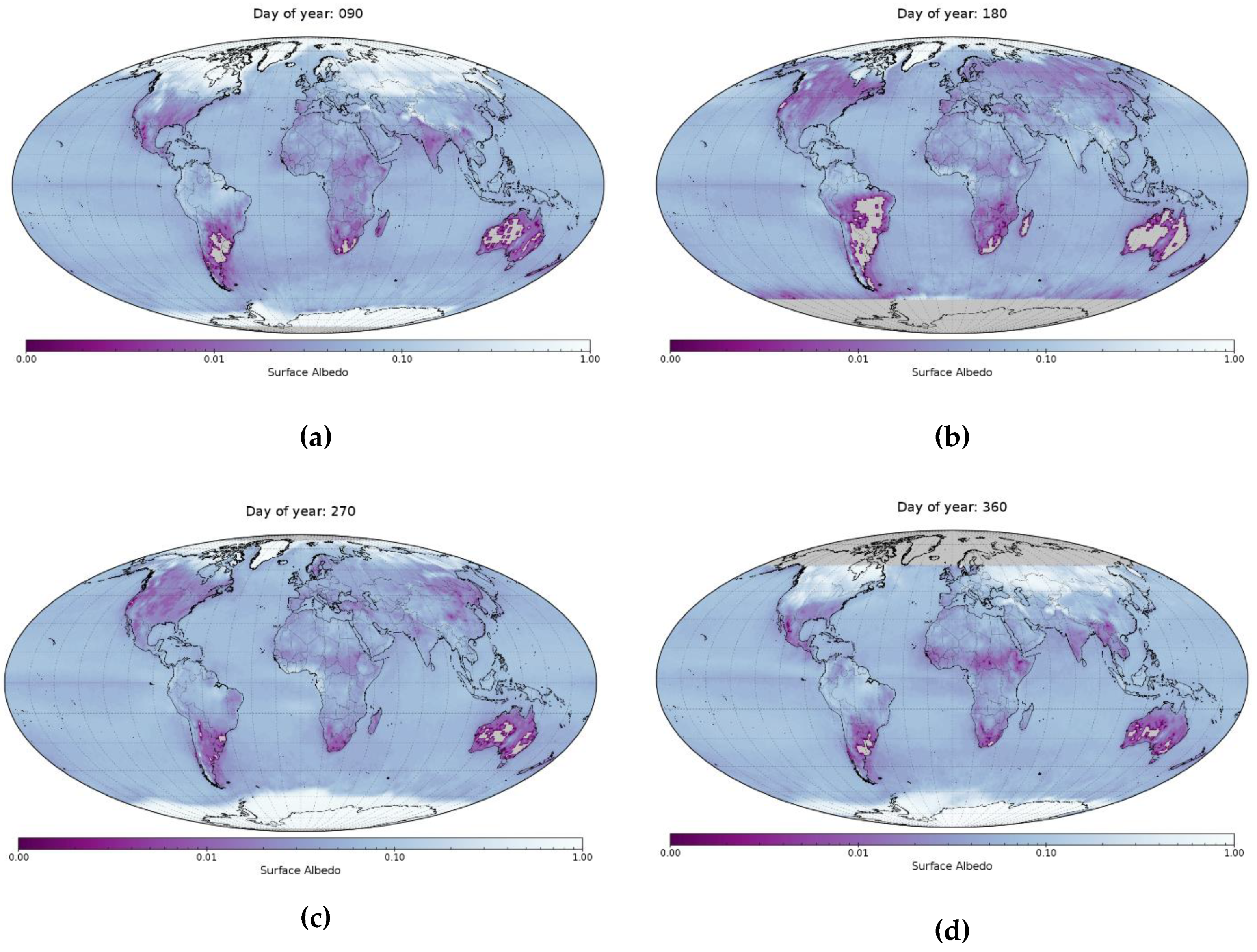

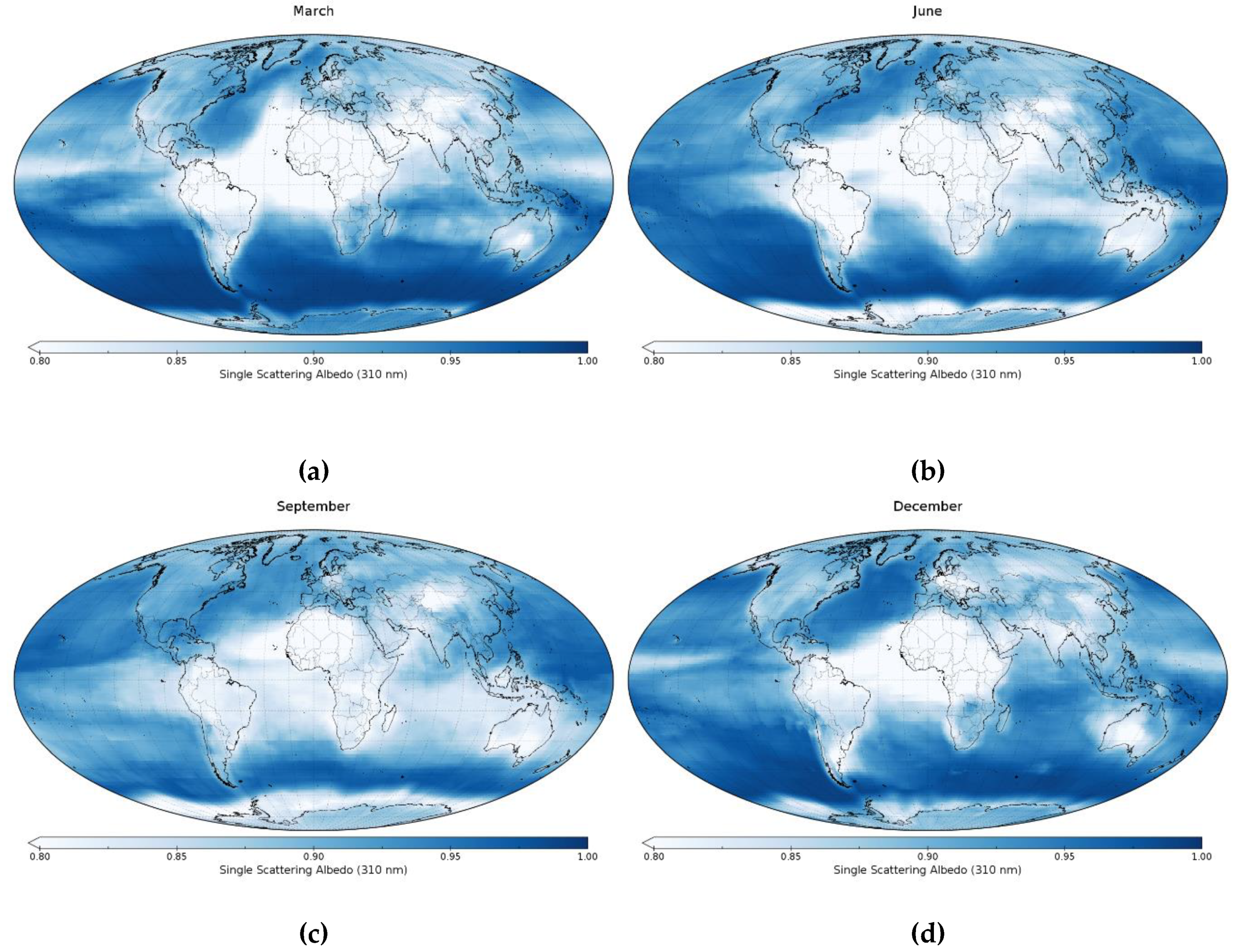
| Station ID | UVI | UV-A | |||||
|---|---|---|---|---|---|---|---|
| N | R | Bias | RMSE | R | Bias (W/m2) | RMSE (W/m2) | |
| AMS | 366 | 1.00 | 0.34 | 0.42 | 1.00 | 2.05 | 2.56 |
| ANC | 332 | 0.99 | 0.62 | 0.71 | 0.99 | 4.76 | 5.35 |
| ATH | 244 | 1.00 | 0.23 | 0.37 | 0.99 | 0.20 | 1.69 |
| BEI | 244 | 0.99 | −0.42 | 0.57 | 0.99 | −4.17 | 4.70 |
| BER | 352 | 1.00 | 0.14 | 0.28 | 1.00 | 0.49 | 1.96 |
| DOU | 244 | 0.99 | −0.38 | 1.02 | 0.99 | −1.77 | 4.35 |
| DUB | 244 | 0.98 | −0.57 | 0.75 | 0.95 | −4.42 | 5.17 |
| HEL | 340 | 0.99 | 0.29 | 0.36 | 0.99 | 1.74 | 2.37 |
| HON | 244 | 1.00 | 0.82 | 0.96 | 1.00 | 3.81 | 4.13 |
| JAK | 244 | 1.00 | 0.40 | 0.60 | 1.00 | 1.28 | 2.48 |
| KAN | 415 | 0.98 | 0.46 | 0.55 | 0.98 | 4.20 | 5.11 |
| KAT | 352 | 1.00 | 0.23 | 0.35 | 1.00 | 0.25 | 1.87 |
| KIE | 274 | 0.99 | 0.14 | 0.30 | 0.99 | 0.26 | 2.09 |
| LON | 469 | 0.98 | 0.54 | 0.60 | 0.98 | 5.95 | 6.41 |
| MEX | 244 | 1.00 | 1.51 | 1.85 | 1.00 | 4.51 | 4.81 |
| MOS | 270 | 0.98 | 0.18 | 0.33 | 0.98 | 0.68 | 2.39 |
| NAI | 244 | 0.94 | 0.63 | 0.98 | 0.89 | 1.58 | 4.07 |
| OSL | 355 | 1.00 | 0.24 | 0.32 | 1.00 | 1.35 | 2.11 |
| PAR | 366 | 1.00 | 0.38 | 0.47 | 1.00 | 2.29 | 2.71 |
| QUI | 244 | 1.00 | 1.43 | 1.86 | 1.00 | 4.11 | 4.84 |
| RIO | 244 | 0.98 | 0.28 | 0.35 | 0.95 | 0.98 | 1.91 |
| ROM | 335 | 1.00 | 0.23 | 0.34 | 1.00 | 1.07 | 1.74 |
| SAN | 244 | 1.00 | 0.66 | 0.76 | 0.99 | 2.58 | 3.02 |
| SYD | 244 | 0.99 | 0.43 | 0.47 | 0.99 | 3.05 | 3.22 |
| TOK | 244 | 0.98 | 0.25 | 0.35 | 0.95 | 0.25 | 1.54 |
| TOR | 348 | 1.00 | 0.29 | 0.39 | 1.00 | 1.42 | 2.04 |
| Station ID | L2LEO | LEOLEO | LEOLEO_GEOGEO | LEO_GEO | L2LEO_L2GEO | |||||||||||
|---|---|---|---|---|---|---|---|---|---|---|---|---|---|---|---|---|
| N | Rel. R | Rel. Bias | Rel. RMSE | Rel. R | Rel. Bias | Rel. RMSE | Rel. R | Rel. Bias | Rel. RMSE | Rel. R | Rel. Bias | Rel. RMSE | Rel. R | Rel. Bias | Rel. RMSE | |
| AMS | 366 | 1.001 | 0.69 | 0.71 | 1.000 | 1.39 | 1.20 | 1.000 | 0.58 | 0.73 | 1.001 | 0.60 | 0.74 | 1.000 | 0.63 | 0.76 |
| ANC | 332 | 1.001 | 1.18 | 1.04 | 1.000 | 0.35 | 0.84 | 0.999 | 0.39 | 0.88 | 0.999 | 0.37 | 0.85 | 1.001 | 1.17 | 1.04 |
| ATH | 244 | 1.001 | 0.69 | 0.81 | 1.001 | 2.17 | 1.15 | 1.001 | 0.77 | 0.80 | 1.001 | 0.78 | 0.80 | 1.001 | 0.87 | 0.81 |
| BEI | 244 | 1.001 | 0.81 | 0.79 | 1.001 | 1.80 | 1.29 | 1.001 | 1.79 | 1.28 | 1.001 | 1.79 | 1.29 | 1.001 | 0.81 | 0.79 |
| BER | 352 | 1.001 | 0.60 | 0.64 | 1.001 | 1.19 | 1.07 | 1.001 | 0.56 | 0.64 | 1.001 | 0.56 | 0.65 | 1.001 | 0.61 | 0.68 |
| DOU | 244 | 1.000 | 0.74 | 0.78 | 0.999 | 0.60 | 0.70 | 0.999 | 0.59 | 0.70 | 0.999 | 0.58 | 0.69 | 1.000 | 0.73 | 0.77 |
| DUB | 244 | 1.003 | 9.22 | 0.94 | 1.001 | 21.41 | 1.91 | 1.000 | 21.65 | 1.97 | 1.000 | 21.74 | 1.98 | 1.003 | 9.15 | 0.94 |
| HEL | 340 | 1.001 | 0.58 | 0.72 | 1.001 | 1.22 | 1.08 | 1.000 | 0.50 | 0.70 | 1.000 | 0.53 | 0.71 | 1.000 | 0.50 | 0.72 |
| HON | 244 | 1.000 | 3.20 | 1.45 | 1.000 | 6.22 | 2.37 | 1.000 | 6.19 | 2.36 | 1.000 | 6.21 | 2.36 | 1.000 | 3.22 | 1.45 |
| JAK | 244 | 1.000 | 1.09 | 1.08 | 1.000 | 1.43 | 1.40 | 1.000 | 1.43 | 1.40 | 1.000 | 1.43 | 1.40 | 1.000 | 1.09 | 1.08 |
| KAN | 415 | 1.000 | 1.53 | 1.32 | 1.000 | 1.24 | 1.18 | 0.999 | 1.38 | 1.29 | 0.999 | 1.41 | 1.30 | 1.000 | 1.51 | 1.34 |
| KAT | 352 | 1.001 | 1.14 | 1.08 | 1.000 | 1.41 | 1.35 | 1.000 | 1.40 | 1.34 | 1.000 | 1.40 | 1.35 | 1.001 | 1.13 | 1.08 |
| KIE | 274 | 1.002 | 0.51 | 0.62 | 1.001 | 0.97 | 0.94 | 1.001 | 0.51 | 0.63 | 1.001 | 0.51 | 0.64 | 1.001 | 0.52 | 0.64 |
| LON | 469 | 1.001 | 0.41 | 0.72 | 0.998 | 0.74 | 0.93 | 0.999 | 0.75 | 0.96 | 0.998 | 0.70 | 0.96 | 0.999 | 0.39 | 0.77 |
| MEX | 244 | 1.000 | 1.91 | 1.79 | 0.998 | 2.43 | 2.27 | 0.998 | 2.43 | 2.27 | 0.998 | 2.43 | 2.27 | 1.000 | 1.92 | 1.80 |
| MOS | 270 | 1.003 | 0.26 | 0.62 | 1.001 | 0.84 | 0.89 | 1.003 | 0.23 | 0.60 | 1.003 | 0.24 | 0.62 | 1.002 | 0.27 | 0.66 |
| NAI | 244 | 1.000 | 3.03 | 1.14 | 0.998 | 4.55 | 1.35 | 0.998 | 4.57 | 1.37 | 0.998 | 4.61 | 1.37 | 1.000 | 3.03 | 1.14 |
| OSL | 355 | 1.001 | 0.53 | 0.62 | 1.001 | 1.20 | 1.07 | 1.001 | 0.49 | 0.66 | 1.001 | 0.50 | 0.65 | 1.001 | 0.50 | 0.68 |
| PAR | 366 | 1.001 | 0.77 | 0.72 | 1.000 | 2.72 | 1.37 | 1.000 | 0.72 | 0.85 | 1.001 | 0.77 | 0.82 | 1.000 | 0.75 | 0.89 |
| QUI | 244 | 1.000 | 1.05 | 1.06 | 0.999 | 1.14 | 1.15 | 0.999 | 1.14 | 1.15 | 0.999 | 1.14 | 1.15 | 1.000 | 1.05 | 1.06 |
| RIO | 244 | 1.000 | 0.88 | 0.98 | 0.997 | 1.61 | 1.52 | 0.996 | 1.60 | 1.52 | 0.996 | 1.60 | 1.51 | 1.000 | 0.90 | 0.98 |
| ROM | 335 | 1.000 | 0.48 | 0.74 | 1.000 | 2.00 | 1.29 | 1.000 | 0.53 | 0.82 | 1.000 | 0.56 | 0.83 | 1.000 | 0.57 | 0.86 |
| SAN | 244 | 1.005 | 1.85 | 1.16 | 1.004 | 2.93 | 1.60 | 1.004 | 2.93 | 1.60 | 1.004 | 2.93 | 1.60 | 1.005 | 1.85 | 1.15 |
| SYD | 244 | 1.001 | 0.82 | 0.72 | 0.999 | 2.87 | 1.33 | 0.999 | 2.86 | 1.33 | 0.999 | 2.76 | 1.30 | 1.001 | 0.82 | 0.72 |
| TOK | 244 | 1.003 | 0.78 | 1.03 | 1.000 | 3.36 | 1.49 | 1.000 | 3.35 | 1.49 | 1.000 | 3.36 | 1.50 | 1.003 | 0.78 | 1.03 |
| TOR | 348 | 1.001 | 0.60 | 0.74 | 1.000 | 1.63 | 1.20 | 1.000 | 1.61 | 1.19 | 1.000 | 1.59 | 1.18 | 1.001 | 0.60 | 0.74 |
| Station ID | L2LEO | LEOLEO | LEOLEO_GEOGEO | LEO_GEO | L2LEO_L2GEO | |||||||||||
|---|---|---|---|---|---|---|---|---|---|---|---|---|---|---|---|---|
| N | Rel. R | Rel. Bias | Rel. RMSE | Rel. R | Rel. Bias | Rel. RMSE | Rel. R | Rel. Bias | Rel. RMSE | Rel. R | Rel. Bias | Rel. RMSE | Rel. R | Rel. Bias | Rel. RMSE | |
| AMS | 366 | 1.000 | 0.59 | 0.99 | 1.000 | 1.52 | 1.02 | 1.000 | 0.42 | 0.99 | 1.000 | 0.44 | 0.99 | 1.000 | 0.47 | 0.99 |
| ANC | 332 | 1.000 | 1.00 | 1.00 | 1.000 | 0.98 | 0.98 | 1.000 | 0.98 | 0.99 | 1.000 | 0.98 | 0.98 | 1.000 | 1.00 | 1.00 |
| ATH | 244 | 1.000 | 0.97 | 1.00 | 1.000 | 1.09 | 1.00 | 1.000 | 0.97 | 1.00 | 1.000 | 0.97 | 1.00 | 1.000 | 0.98 | 1.00 |
| BEI | 244 | 1.000 | 0.99 | 1.00 | 1.000 | 1.03 | 1.02 | 1.000 | 1.03 | 1.01 | 1.000 | 1.03 | 1.02 | 1.000 | 0.99 | 1.00 |
| BER | 352 | 1.000 | 0.64 | 0.97 | 1.000 | 1.17 | 1.02 | 1.000 | 0.59 | 0.98 | 1.000 | 0.59 | 0.98 | 1.000 | 0.63 | 0.98 |
| DOU | 244 | 1.000 | 1.00 | 1.00 | 1.000 | 0.99 | 0.99 | 1.000 | 0.99 | 0.99 | 1.000 | 0.99 | 0.99 | 1.000 | 1.00 | 1.00 |
| DUB | 244 | 1.000 | 0.95 | 0.98 | 1.000 | 0.89 | 0.96 | 1.000 | 0.89 | 0.96 | 1.000 | 0.89 | 0.96 | 1.000 | 0.95 | 0.98 |
| HEL | 340 | 1.000 | 1.22 | 1.00 | 1.000 | 0.87 | 1.00 | 1.000 | 1.25 | 0.99 | 1.000 | 1.23 | 1.00 | 1.000 | 1.25 | 0.99 |
| HON | 244 | 1.000 | 1.12 | 1.09 | 1.000 | 1.23 | 1.18 | 1.000 | 1.23 | 1.17 | 1.000 | 1.23 | 1.17 | 1.000 | 1.12 | 1.09 |
| JAK | 244 | 1.000 | 1.00 | 1.00 | 1.000 | 1.03 | 1.02 | 1.000 | 1.03 | 1.02 | 1.000 | 1.03 | 1.02 | 1.000 | 1.00 | 1.00 |
| KAN | 415 | 1.000 | 1.01 | 1.01 | 1.000 | 1.00 | 1.00 | 1.000 | 1.01 | 1.01 | 1.000 | 1.01 | 1.01 | 1.000 | 1.01 | 1.01 |
| KAT | 352 | 1.000 | 1.00 | 1.00 | 1.000 | 1.01 | 1.01 | 1.000 | 1.01 | 1.01 | 1.000 | 1.01 | 1.01 | 1.000 | 1.00 | 1.00 |
| KIE | 274 | 1.000 | 2.11 | 1.00 | 1.000 | 1.06 | 1.00 | 1.000 | 2.12 | 1.00 | 1.000 | 2.11 | 1.01 | 1.000 | 2.09 | 1.00 |
| LON | 469 | 1.000 | 1.11 | 1.00 | 1.000 | 1.05 | 1.00 | 1.000 | 1.05 | 1.00 | 1.000 | 1.06 | 1.00 | 1.000 | 1.11 | 1.00 |
| MEX | 244 | 1.000 | 1.02 | 1.02 | 1.000 | 1.03 | 1.03 | 1.000 | 1.03 | 1.03 | 1.000 | 1.03 | 1.03 | 1.000 | 1.02 | 1.02 |
| MOS | 270 | 1.000 | 1.08 | 1.03 | 1.000 | 1.02 | 1.01 | 1.000 | 1.08 | 1.04 | 1.000 | 1.08 | 1.04 | 1.000 | 1.08 | 1.03 |
| NAI | 244 | 1.000 | 0.99 | 1.00 | 1.000 | 0.98 | 1.00 | 1.000 | 0.98 | 1.00 | 1.000 | 0.98 | 1.00 | 1.000 | 0.99 | 1.00 |
| OSL | 355 | 1.000 | 0.94 | 0.99 | 1.000 | 1.02 | 1.01 | 1.000 | 0.94 | 0.99 | 1.000 | 0.94 | 0.99 | 1.000 | 0.94 | 0.99 |
| PAR | 366 | 1.000 | 1.02 | 1.01 | 1.000 | 0.87 | 0.98 | 1.000 | 1.03 | 1.01 | 1.000 | 1.02 | 1.01 | 1.000 | 1.02 | 1.01 |
| QUI | 244 | 1.000 | 1.00 | 1.00 | 1.000 | 1.00 | 1.00 | 1.000 | 1.00 | 1.00 | 1.000 | 1.00 | 1.00 | 1.000 | 1.00 | 1.00 |
| RIO | 244 | 1.000 | 1.21 | 1.01 | 1.000 | 0.11 | 1.01 | 1.000 | 0.12 | 1.01 | 1.000 | 0.13 | 1.01 | 1.000 | 1.18 | 1.01 |
| ROM | 335 | 1.000 | 1.04 | 1.01 | 1.000 | 0.93 | 0.99 | 1.000 | 1.04 | 1.01 | 1.000 | 1.04 | 1.01 | 1.000 | 1.04 | 1.01 |
| SAN | 244 | 1.000 | 0.97 | 0.99 | 1.000 | 0.91 | 0.99 | 1.000 | 0.91 | 0.99 | 1.000 | 0.91 | 0.99 | 1.000 | 0.97 | 0.99 |
| SYD | 244 | 1.000 | 1.02 | 1.01 | 1.000 | 0.97 | 0.98 | 1.000 | 0.97 | 0.98 | 1.000 | 0.97 | 0.98 | 1.000 | 1.02 | 1.01 |
| TOK | 244 | 1.000 | 0.98 | 0.99 | 1.000 | 0.92 | 0.96 | 1.000 | 0.92 | 0.96 | 1.000 | 0.92 | 0.96 | 1.000 | 0.98 | 0.99 |
| TOR | 348 | 1.000 | 1.35 | 1.05 | 1.000 | 0.50 | 1.02 | 1.000 | 0.51 | 1.02 | 1.000 | 0.53 | 1.02 | 1.000 | 1.35 | 1.05 |
References
- Cortesi, U.; Ceccherini, S.; del Bianco, S.; Gai, M.; Tirelli, C.; Zoppetti, N.; Barbara, F.; Bonazountas, M.; Argyridis, A.; Bós, A.; et al. Advanced Ultraviolet Radiation and Ozone Retrieval for Applications (AURORA): A Project Overview. Atmosphere 2018, 9, 454. [Google Scholar] [CrossRef]
- Eck, T.F.; Bhartia, P.K.; Kerr, J.B. Satellite estimation of spectral UVB irradiance using TOMS derived total ozone and UV reflectivity. Geophys. Res. Lett. 1995, 611–614. [Google Scholar] [CrossRef]
- Tanskanen, A.; Krotkov, N.A.; Herman, J.R.; Arola, A. Surface Ultraviolet Irradiance from OMI. IEEE Trans. Geosci. Remote Sens. 2006, 44, 1267–1271. [Google Scholar] [CrossRef]
- Lindfors, A.V.; Kujanpää, J.; Kalakoski, N.; Heikkilä, A.; Lakkala, K.; Mielonen, T.; Sneep, M.; Krotkov, N.A.; Arola, A.; Tamminnen, J. The Tropomi surface UV algorithm. Atmos. Meas. Tech. 2018, 11, 997–1008. [Google Scholar] [CrossRef]
- Emde, C.; Buras-Schnell, R.; Kylling, A.; Mayer, B.; Gasteiger, J.; Hamann, U.; Kylling, J.; Richter, B.; Pause, C.; Dowling, T.; et al. The libRadtran software package for radiative transfer calculations (version 2.0.1). Geosci. Model Dev. 2016, 9, 1647–1672. [Google Scholar] [CrossRef]
- Stamnes, K.; Tsay, S.C.; Wiscombe, W.; Jayaweera, K. Numerically stable algorithm for discrete-ordinate-method radiative transfer in multiple scattering and emitting layered media. Appl Opt. 1988, 27, 2502–2509. [Google Scholar] [CrossRef] [PubMed]
- United States Committee on Extension to the Standard Atmosphere. National Oceanic and Atmospheric Administration, Washington, DC (NOAA-S/T 76-1562): Supt. of Docs., US Gov Print Office (Stock No. 003-017-00323-0); United States Committee on Extension to the Standard Atmosphere: Washington, DC, USA, 1976.
- Tanskanen, A.; Arola, A.; Kujanpää, J. Use of the moving time-window technique to determine surface albedo from the TOMS reflectivity data. Proc. SPIE 2003, 4896, 239–250. [Google Scholar]
- Tanskanen, A. Lambertian Surface Albedo Climatology at 360 nm from TOMS Data Using Moving Time-Window Technique. In Proceedings of the XX Quadrennial Ozone Symposium, Kos, Greece, 1–8 June 2004. [Google Scholar]
- Kinne, S.; O’Donnel, D.; Stier, P.; Kloster, S.; Zhang, K.; Schmidt, H.; Rast, S.; Giorgetta, M.; Eck, T.F.; Stevens, B. MAC-v1: A new global aerosol climatology for climate studies. J. Adv. Model. Earth Syst. 2013, 5, 704–740. [Google Scholar] [CrossRef]
- World Health Organization; World Meteorological Organization. Global Solar UV Index: A Practical Guide; WHO: Geneva, Switzerland, 2002; p. 28. [Google Scholar]
- McKinlay, A.F.; Diffey, B.L. A reference action spectrum for ultraviolet induced erythema in human skin, in: Commission International de l’Éclairage (CIE). Res. Note 1987, 6, 17–22. [Google Scholar]
- Amaro-Ortiz, A.; Yan, B.; D’Orazio, J.A. Ultraviolet radiation, aging and the skin: Prevention of damage by topical cAMP manipulation. Molecules 2014, 19, 6202–6219. [Google Scholar] [CrossRef] [PubMed]
- Venditti, E.; Brugè, F.; Astolfi, P.; Kochevar, I.; Damiani, E. Nitroxides and a nitroxide-based UV filter have the potential to photoprotect UVA-irradiated human skin fibroblasts against oxidative damage. J. Dermatol. Sci. 2011, 63, 55–61. [Google Scholar] [CrossRef] [PubMed]
- Gelaro, R.; Mccarty, W.; Suárez, M.J.; Todling, R.; Molod, A.; Takacs, L.; Randles, C.; Darmenov, A.; Bosilovich, M.G.; Reichle, R.H.; et al. The Modern-Era Retrospective Analysis for Research and Applications, Version 2 (MERRA-2). J. Clim. 2017, 30, 5419–5454. [Google Scholar] [CrossRef] [PubMed]
- Ceccherini, S.; Carli, B.; Tirelli, C.; Zoppetti, N.; Del Bianco, S.; Cortesi, U.; Kujanpää, J.; Dragani, R. Importance of interpolation and coincidence errors in data fusion. Atmos. Meas. Tech. 2018, 11, 1009–1017. [Google Scholar] [CrossRef]
- Zoppetti, N.; Ceccherini, S.; Carli, B.; Del Bianco, S.; Gai, M.; Tirelli, C.; Barbara, F.; Dragani, R.; Arola, A.; Kujanpää, J.; et al. The Complete Data Fusion for a Full Exploitation of Copernicus Atmospheric Sentinel Level 2 Products. Atmos. Meas. Tech. Discuss. 2019, 1–13. [Google Scholar] [CrossRef]
- Ceccherini, S.; Carli, B.; Raspollini, P. Equivalence of data fusion and simultaneous retrieval. Opt. Express 2015, 23, 8476–8488. [Google Scholar] [CrossRef] [PubMed]
- Tirelli, C.; Ceccherini, S.; Zoppetti, N.; Del Bianco, S.; Gai, M.; Barbara, F.; Cortesi, U.; Kujanpää, J.; Huan, Y.; Dragani, R. Data fusion analysis of Sentinel-4 and Sentinel-5 simulated ozone data. J. Atmos. Ocean. Technol. 2020. [Google Scholar] [CrossRef]
- Huijnen, V.; Williams, J.; Van Weele, M.; Van Noije, T.; Król, M.; Dentener, F.; Segers, A.; Houweling, S.; Peters, W.; De Laat, J.; et al. The global chemistry transport model TM5: Description and evaluation of the tropospheric chemistry version 3.0. Geosci. Model Dev. 2010, 3, 445–473. [Google Scholar] [CrossRef]

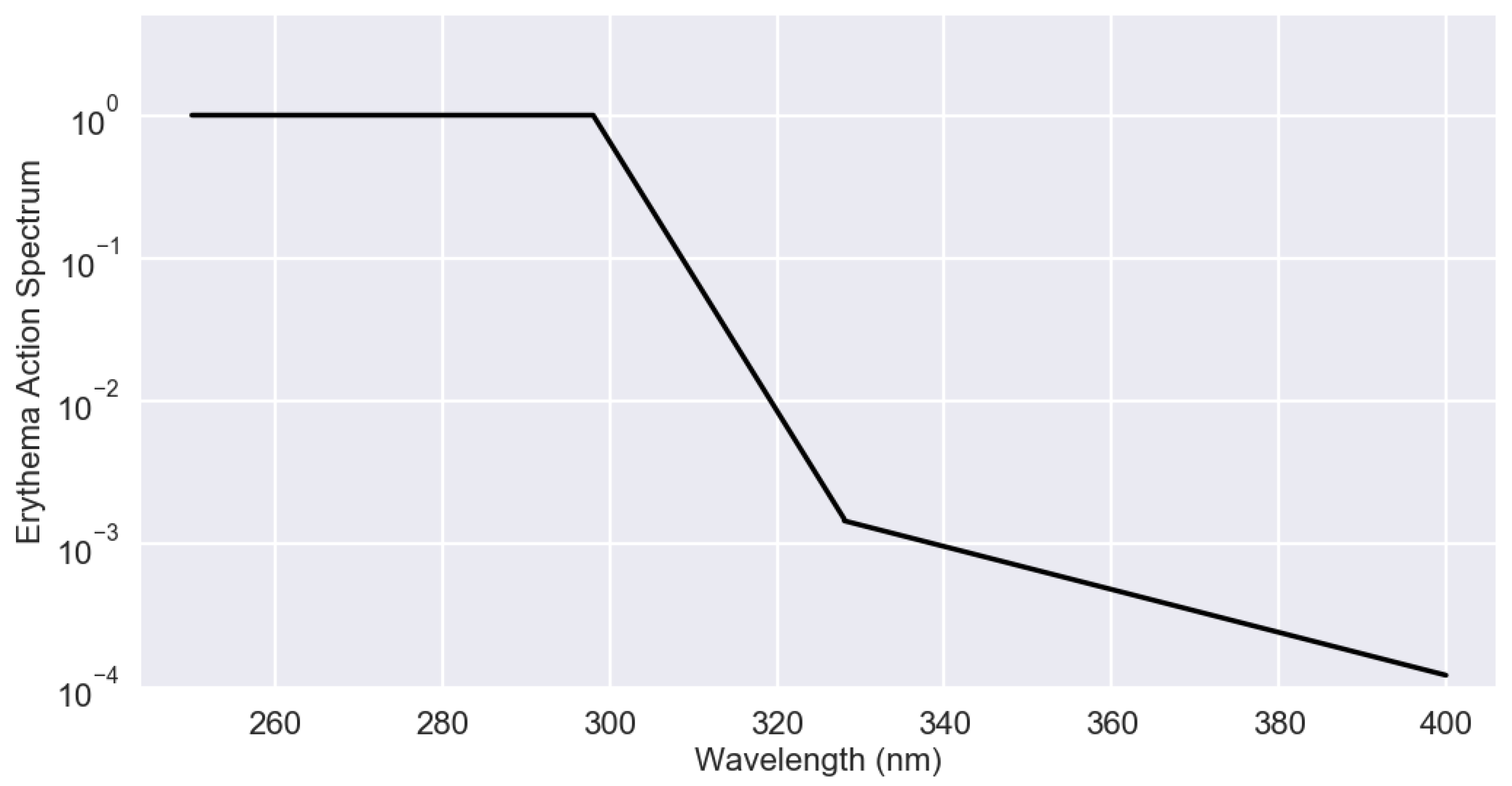
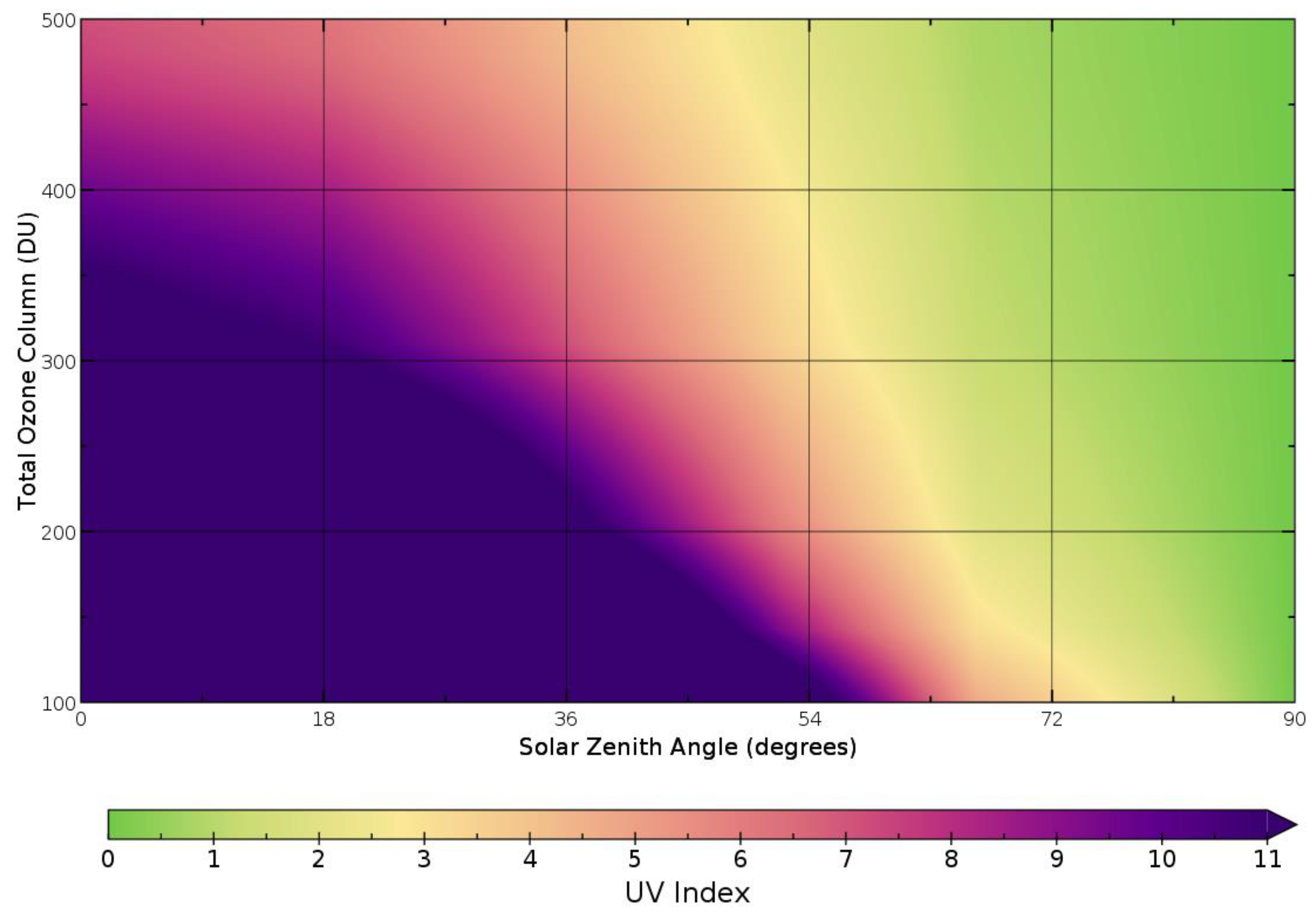
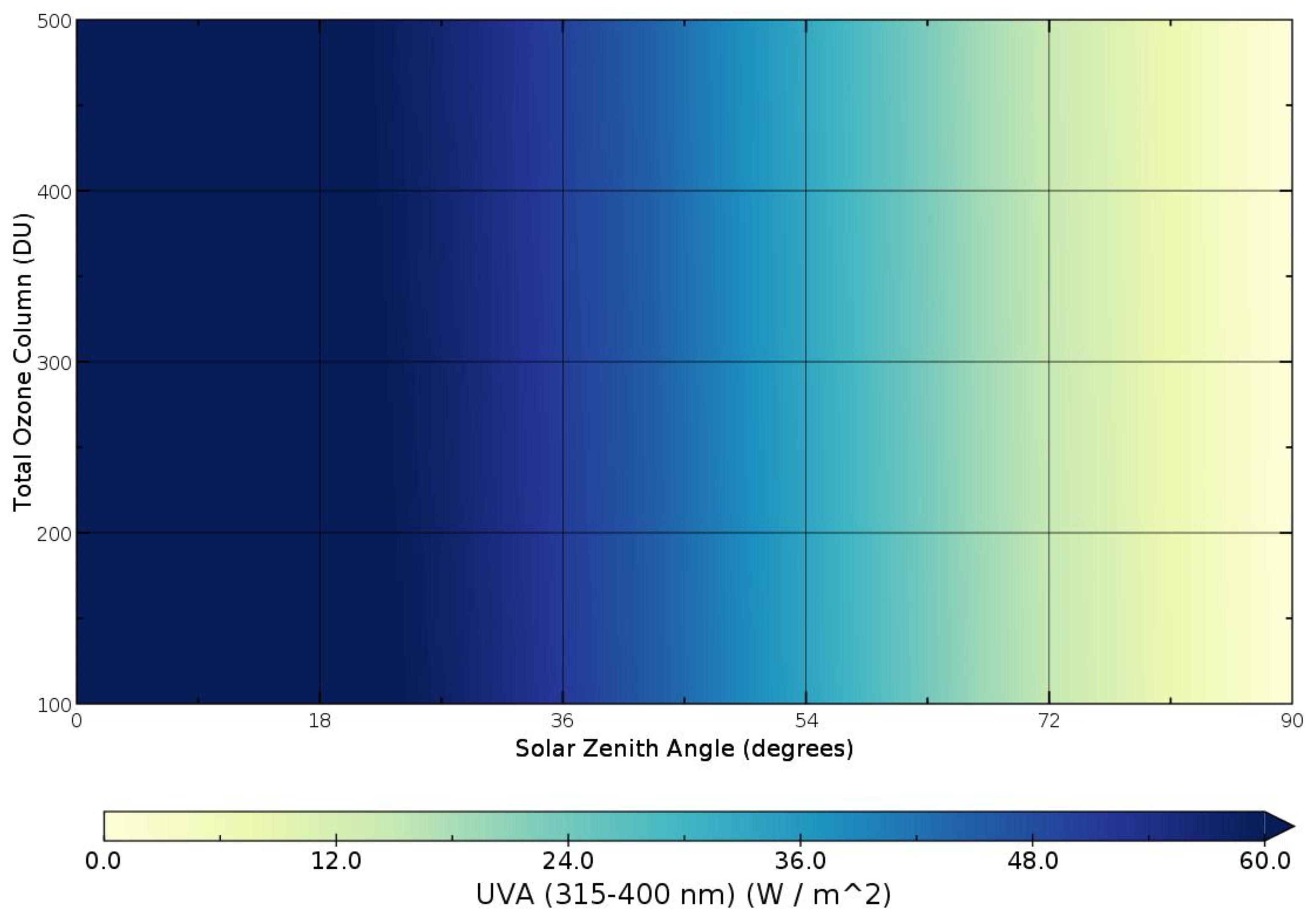
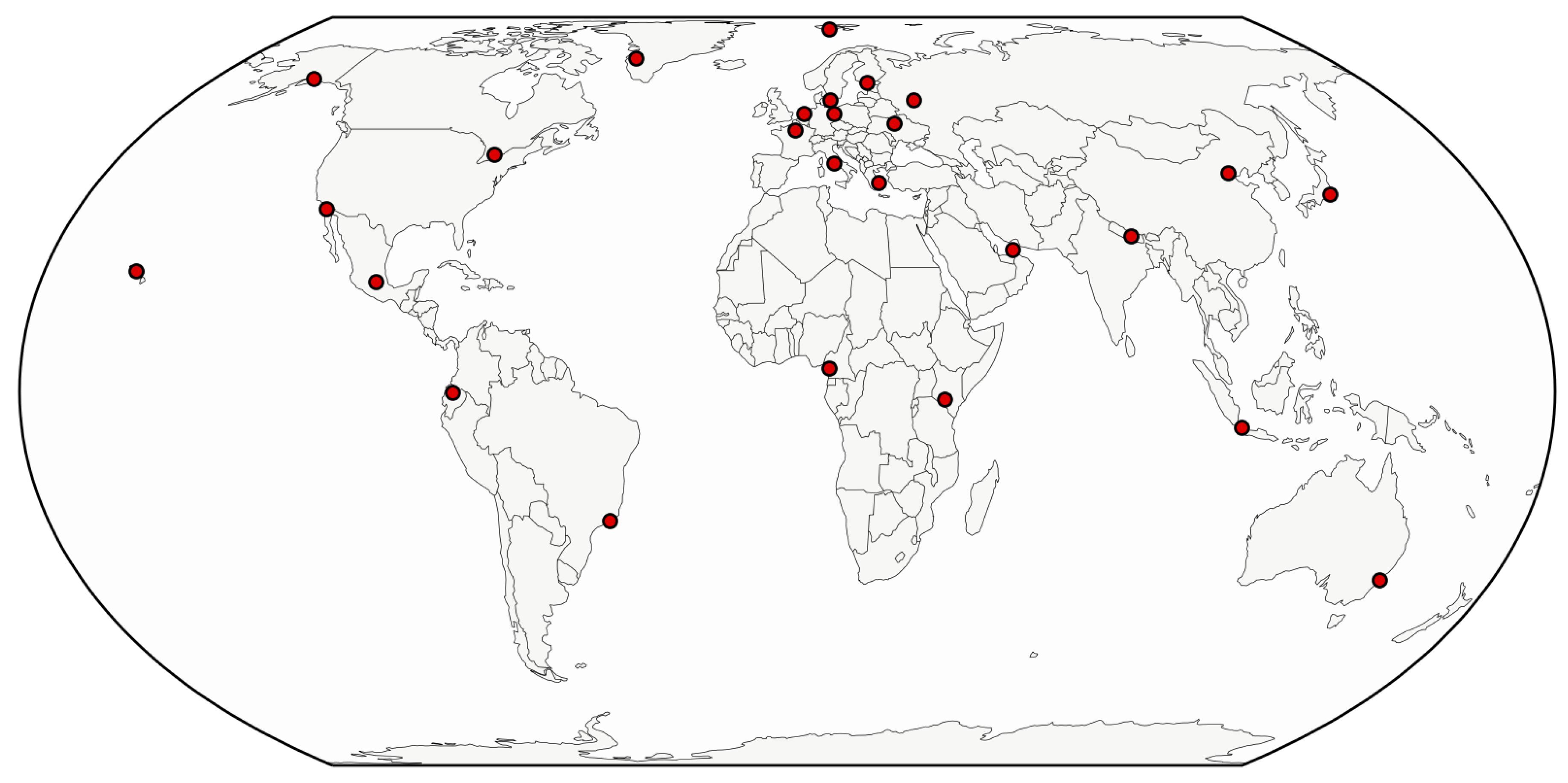




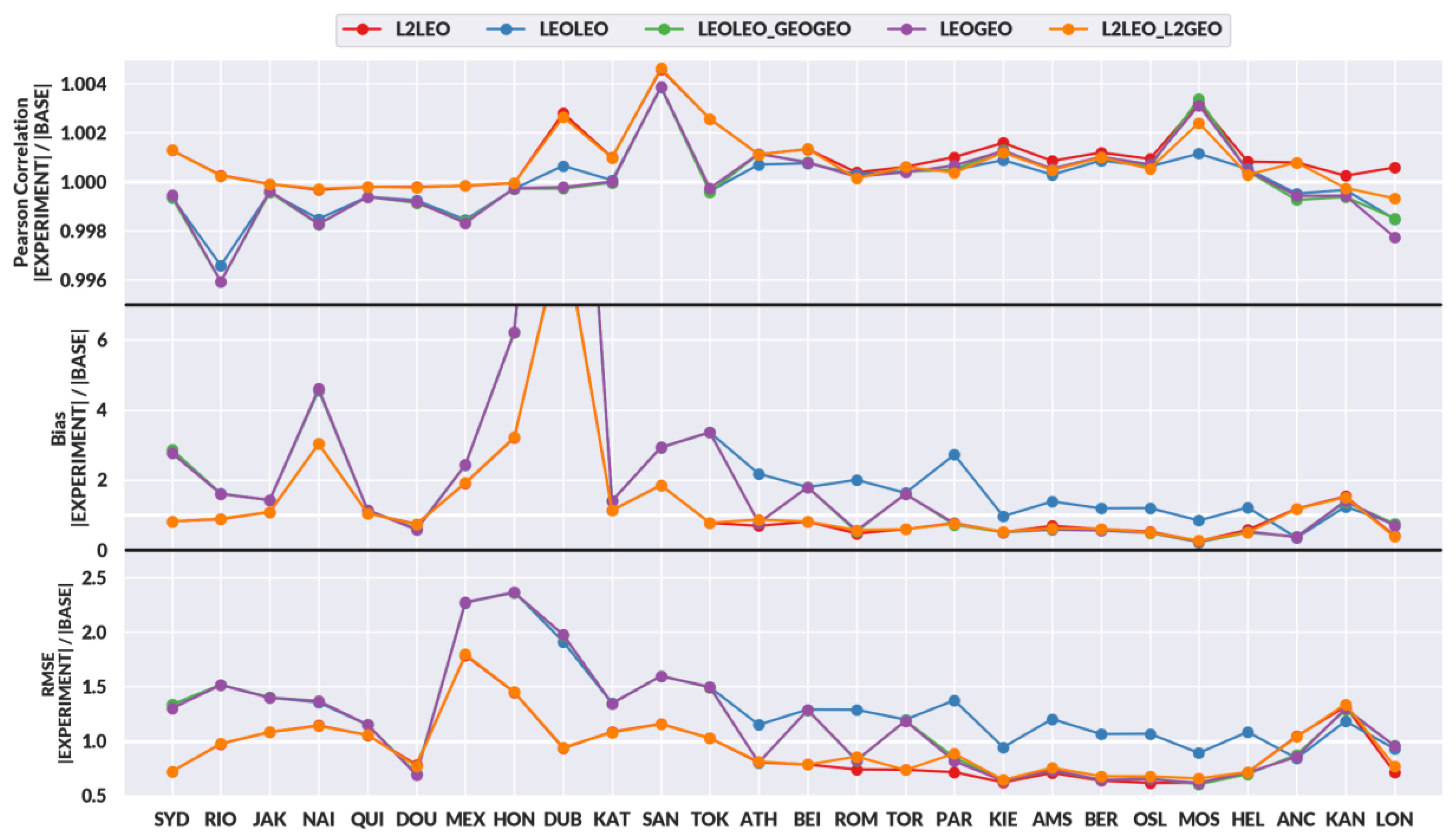
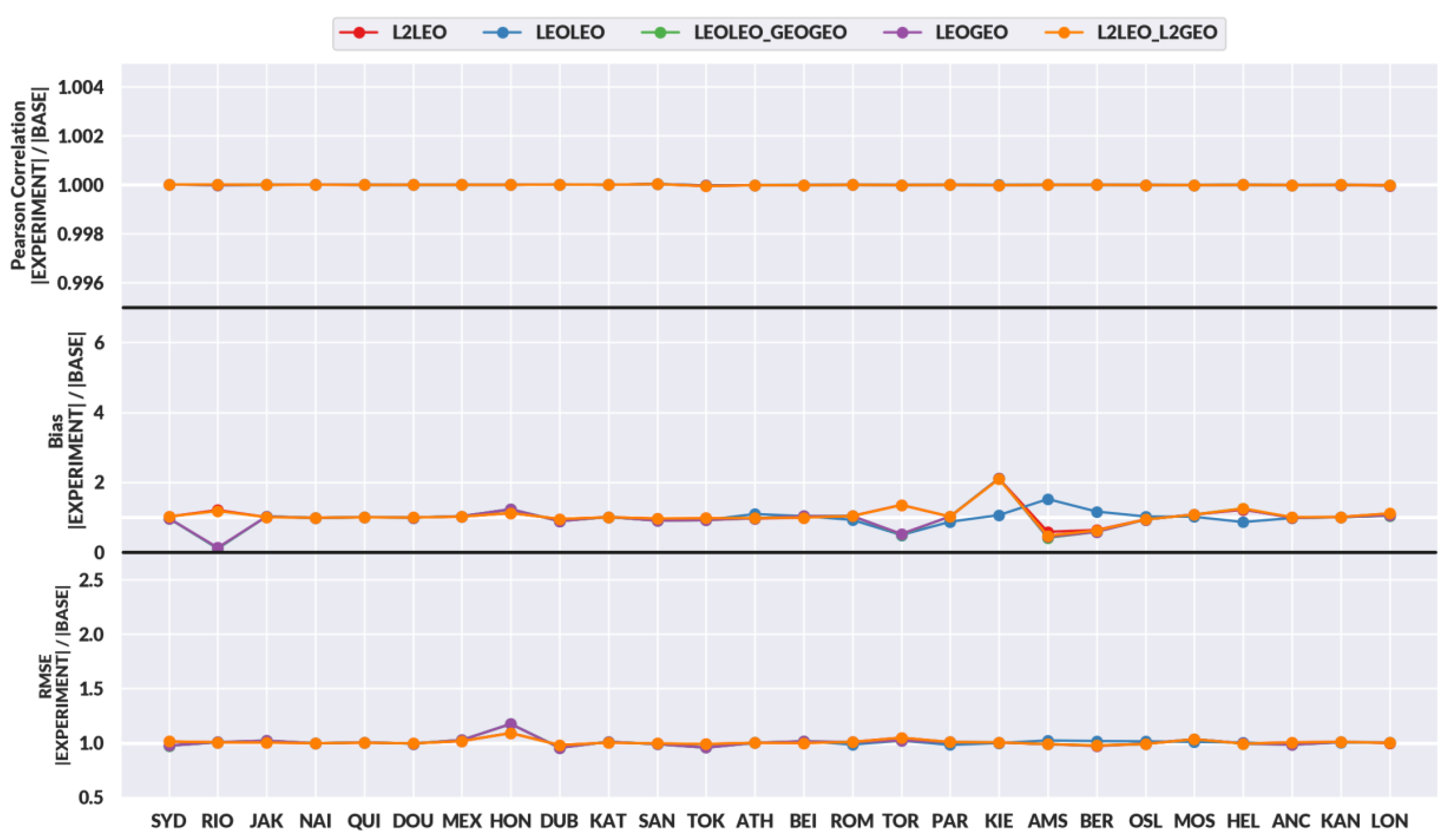
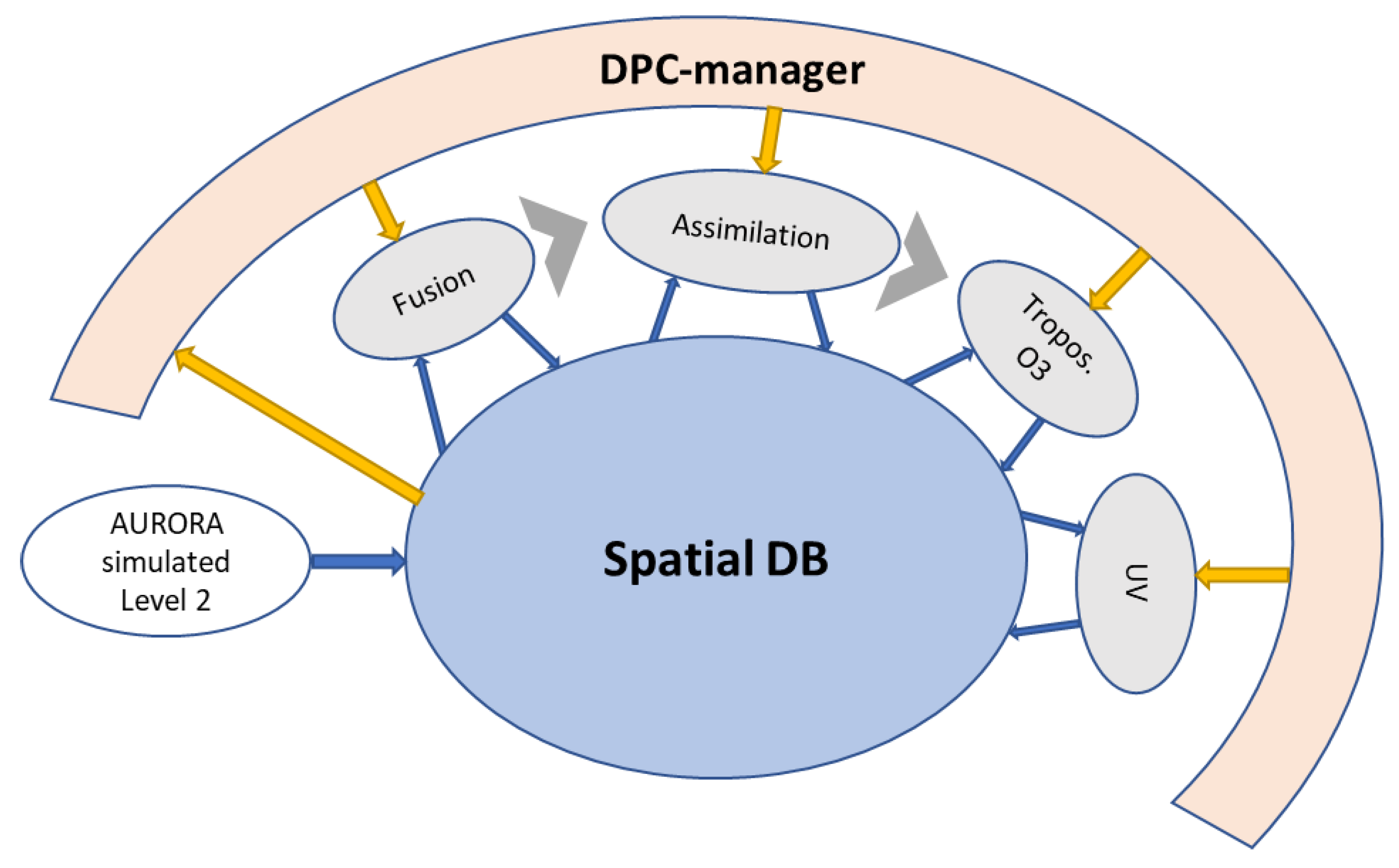
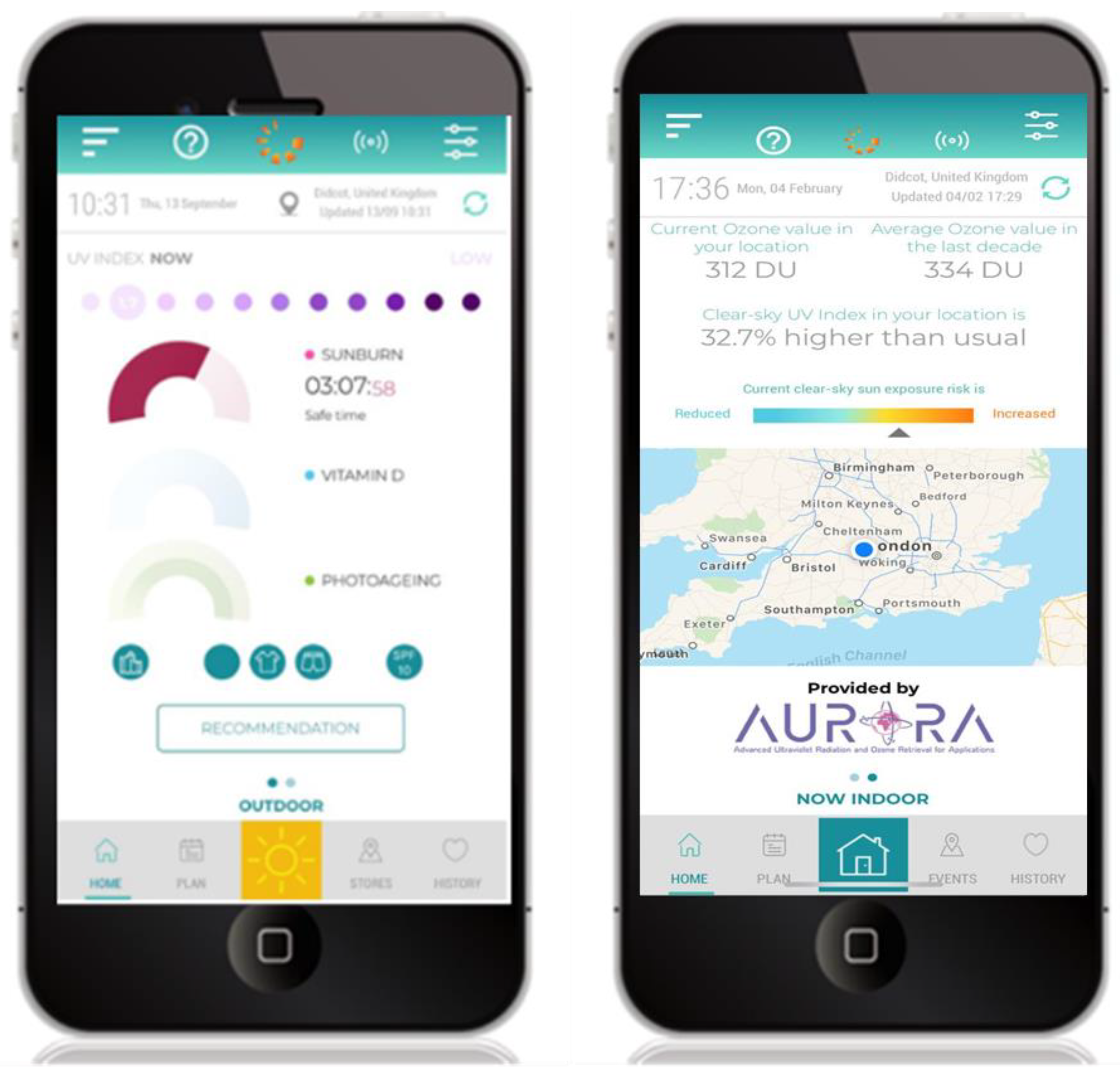
| Input Parameter | Look-up Table Points |
|---|---|
| Total Column Ozone (DU) | 50, 97, 146, 206, 311, 471, 700 |
| Surface Albedo | 0.00, 0.48, 0.70, 0.85, 1.00 |
| Aerosol Optical Depth | 0.00, 0.16, 0.36, 0.65, 1.05, 1.59, 2.00 |
| Aerosol Single Scattering Albedo | 0.50, 0.76, 0.89, 1.00 |
| Cloud Optical Thickness | 0.0, 6.9, 14.7, 25.3, 39.5, 57.8, 84.6, 140.0 |
| Solar Zenith Angle (degrees) | 0.00, 18.4, 30.3, 41.3, 52.7, 66.1, 90.0 |
| Surface Elevation (m) | 0, 2780, 5230, 6810, 8000 |
| Station ID | Location | Latitude (degrees) | Longitude (degrees) |
|---|---|---|---|
| AMS | Amsterdam, Netherlands | 52.4° N | 4.9° E |
| ANC | Anchorage, USA | 61.2° N | 149.1° W |
| ATH | Athens, Greece | 38° N | 23.7° E |
| BEI | Beijing, China | 39.9° N | 116.4° E |
| BER | Berlin, Germany | 52.5° N | 13.4° E |
| DOU | Douala, Cameroon | 4.1° N | 9.7° E |
| DUB | Dubai, United Arab Emirates | 25.2° N | 55.3° E |
| HEL | Helsinki, Finland | 60.2° N | 24.9° E |
| HON | Honolulu, Hawaii | 21.3° N | 157.8° W |
| JAK | Jakarta, Indonesia | 6.2° S | 106.8° E |
| KAN | Kangerlussuaq, Greenland | 67° N | 50.7° W |
| KAT | Kathmandu, Nepal | 27.7° N | 85.3° E |
| KIE | Kiev, Ukraine | 50.4° N | 30.5° E |
| LON | Longyearbyen, Svalbard | 78.2° N | 15.6° E |
| MEX | Mexico City, Mexico | 19.4° N | 99.1° W |
| MOS | Moscow, Russia | 55.8° N | 37.6° E |
| NAI | Nairobi, Kenya | 1.3° S | 36.8° E |
| OSL | Oslo, Norway | 55.7° N | 12.6° E |
| PAR | Paris, France | 48.9° N | 2.3° E |
| QUI | Quito, Ecuador | 0.2° S | 78.5° W |
| RIO | Rio de Janeiro, Brasil | 22.9° S | 43.2° W |
| ROM | Rome, Italy | 41.9° N | 12.5° E |
| SAN | San Diego, USA | 32.8° N | 117.1° W |
| SYD | Sydney, Australia | 33.9° S | 151.2° E |
| TOK | Tokyo, Japan | 35.7° N | 139.8° E |
| TOR | Toronto, Canada | 43.7° N | 79.4° W |
| Experiment Name | Aim of the Experiment |
|---|---|
| L2LEO | To study the impact of assimilation of Sentinel-5 LEO L2 products. |
| LEOLEO | To study the impact of assimilation of Sentinel-5 LEO L2 products after their fusion, versus direct assimilation (L2LEO). |
| LEOLEO_GEOGEO | To study the impact of assimilation of Sentinel-4 GEO and Sentinel-5 LEO fused products, versus LEO only (LEOLEO). |
| LEOGEO | To study the impact of assimilation of a single LEO-GEO (i.e., cross-platform) fused product, versus direct assimilation (L2LEO_L2GEO) or partial fusion (LEOLEO_GEOGEO). |
| L2LEO_L2GEO | To study the impact of direct assimilation of L2 LEO and L2 GEO products without fusion. |
© 2020 by the authors. Licensee MDPI, Basel, Switzerland. This article is an open access article distributed under the terms and conditions of the Creative Commons Attribution (CC BY) license (http://creativecommons.org/licenses/by/4.0/).
Share and Cite
Lipponen, A.; Ceccherini, S.; Cortesi, U.; Gai, M.; Keppens, A.; Masini, A.; Simeone, E.; Tirelli, C.; Arola, A. Advanced Ultraviolet Radiation and Ozone Retrieval for Applications—Surface Ultraviolet Radiation Products. Atmosphere 2020, 11, 324. https://doi.org/10.3390/atmos11040324
Lipponen A, Ceccherini S, Cortesi U, Gai M, Keppens A, Masini A, Simeone E, Tirelli C, Arola A. Advanced Ultraviolet Radiation and Ozone Retrieval for Applications—Surface Ultraviolet Radiation Products. Atmosphere. 2020; 11(4):324. https://doi.org/10.3390/atmos11040324
Chicago/Turabian StyleLipponen, Antti, Simone Ceccherini, Ugo Cortesi, Marco Gai, Arno Keppens, Andrea Masini, Emilio Simeone, Cecilia Tirelli, and Antti Arola. 2020. "Advanced Ultraviolet Radiation and Ozone Retrieval for Applications—Surface Ultraviolet Radiation Products" Atmosphere 11, no. 4: 324. https://doi.org/10.3390/atmos11040324
APA StyleLipponen, A., Ceccherini, S., Cortesi, U., Gai, M., Keppens, A., Masini, A., Simeone, E., Tirelli, C., & Arola, A. (2020). Advanced Ultraviolet Radiation and Ozone Retrieval for Applications—Surface Ultraviolet Radiation Products. Atmosphere, 11(4), 324. https://doi.org/10.3390/atmos11040324







